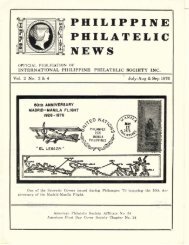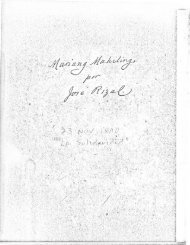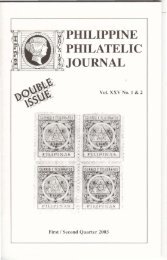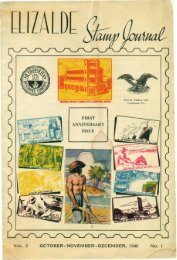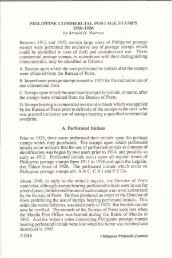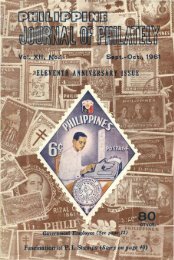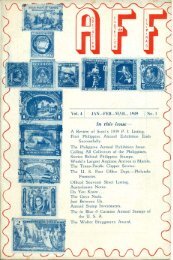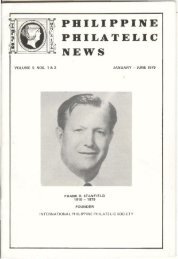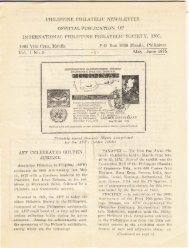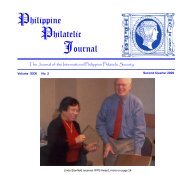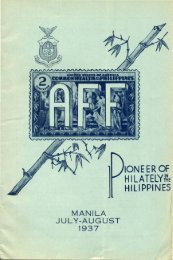Fourth Quarter 1997 - International Philippine Philatelic Society
Fourth Quarter 1997 - International Philippine Philatelic Society
Fourth Quarter 1997 - International Philippine Philatelic Society
You also want an ePaper? Increase the reach of your titles
YUMPU automatically turns print PDFs into web optimized ePapers that Google loves.
UNITED STATES MILITARY STATIONS: THE<br />
POSTAL MARKINGS OF BACOLOD<br />
by Nestor C. Nunez and Alfred F. Kugel<br />
I<br />
1<br />
While Manila and the Central Plain of Luzon are considered the<br />
heartland of the <strong>Philippine</strong>s, the Visayan Islands at the time of the<br />
<strong>Philippine</strong>-American War was an equally important part of the<br />
country in terms ofpopulation and mercantile activities. More importantly<br />
from a military viewpoint, these islands were also a hotbed of<br />
revolutionary fervor. Prominent in this island group are the islands of<br />
Panay, which had the provinces of Antique, Capiz, Iloilo and<br />
Concepcion (this province was later incorporated into Iloilo); Negros,<br />
divided into Negros Oriental and Negros Occidental; and Cebu, an<br />
island province. The major towns,now cities,in these islands are Iloilo,<br />
Bacolod, and Cebu. These three islands had a total population of<br />
1,666,000 (1), compared to thatofLuzon of3,563,000. Iloilo (473,000)<br />
and Cebu provinces (504,000) had more population than the province<br />
of Manila (400,000) (2).<br />
With the collapse of Spanish authority as a result of the Spanish<br />
American War and the resumption of the <strong>Philippine</strong> revolution after<br />
Aguinaldo's return from exile in Hong Kong, a "Visayan Republic"<br />
was set up, composed principally of these three islands. The capital<br />
was Iloilo city, after its capture from the Spanish in December 1898<br />
(3). After the Spanish surrendered Manila on August 13, 1898, the<br />
Spanish forces there retreated to Iloilo. In the interim period, American<br />
and Spanish delegates met in Paris to negotiate the terms of the<br />
peace treaty. During this period, it became evident that the U.S.<br />
wanted to obtain possession of the entire country.<br />
Back in Panay Island, the Spanish forces were beleaguered by the<br />
Filipino revolutionists to the point where the Spanish commander in<br />
Iloilo had to send a message to Gen. Elwell Otis that he could no longer<br />
hold out against the insurgents. Otis responded by creating a Separate<br />
Brigade (4), which proceeded to the Iloilo on December 26, 1898.<br />
After the signing ofthe Treaty of Paris on December 10, the Visayan<br />
Islands became a logical target for American occupation. Thus,<br />
sending an expeditionary force to these islands was a sound military<br />
move as well, sinceAmerican occupation would presumably snuffthe<br />
revolutionary fervor there, thereby ensuring that not many troops<br />
would need to be diverted from Luzon, which presented a greater<br />
military problem with the then uneasy relationship with Emilio<br />
Aguinaldo's revolutionary army.<br />
<strong>Philippine</strong> PhilaJelic Journal 11




